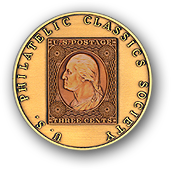
As in past years, the World Series of Philately for single-frame exhibits culminated at ChicagoPEX with the year’s Champion of Champions. There were a total of 20 entries, of which 8 were from Society members, but this year, a non-member won.
Richard Taschenberg won the Multi-frame Reserve Grand with his “Usage History of the “Pumpkin” Envelopes – How and Where They Were Used” (also Multi-frame Large Gold, UPSS Marcus White Award, and the APC Award).
Multi-frame Large Gold was won by three additional Society members:
- Lester C. Lanphear for “U. S. Departmentals. 1873 – 1884” (also USPCS Medal, USSS Medal and the United States Cancellations Club Award).
- Hal Vogel with “American Heroic Age Polar Expeditions”.
- Alfredo Frohlich with “German Prisoners of War Interned in Japan – Their Mail – First World War 1914-1920”.
Multi-frame Gold was won by John Hotchner for “Mail to and from American Prisoners of War During and after the Korean War” and Bob Crossman for “Butterfield’s Overland Mail Company”.
Multi-frame Vermeil was won by Gerry Oberst for “Philatelic Art of Jean-Michel Folon” (also AAPE Award of Honor). Bob Crossman also won Multi-frame Vermeil for “The Printings of the First Greek Stamps”.
10 exhibits from 9 Society members won Single-frame awards.
Single-frame Large Gold was won by:
- Doug Weisz for “The $5 Hamilton Liberty Series Stamp” (also AAPE Single-frame Grand and Best Exhibit by a Chicago Philatelic Society Member).
- Mark Schwartz for “The Use of Boston’s “PAID in Grid” Cancels: 1851-1859” (also AAPE Single-frame Reserve Grand 2).
- John Hotchner for “Bureau of Engraving & Printing Repairs on U.S. Stamp Production 1914 – The Presidential Era”.
- Rev. Stephen Knapp for “Introducing the ABNCo Bust of Peace” and for “An Essay-Proof History for the One Cent Franklin of 1887”.
- Cheryl Ganz for “German Navy WWI Zeppelin L48” (also the Military Postal History Society Best Single-frame).
Two Society members won Single-frame Gold; e.g., Fran Adams for “The Leticia Incident” (also the ATA Best One-Frame); and Wayne Farley for “Confederate “Paid” Uses from West Virginia (1861 – 1864)”.
Evangelos Kobotis won Single-frame Large Silver for “Centenary of First Adhesive Stamps”.
Bill Johnson won Single-frame Silver for “US Western Mail Routes – 1848 – 1865” (also the AAPE Encouragement Award).
The Literature Grand Award was won by Leonard Piszkiewics for “Foreign Incoming Airmail to the United States 1920–1950s” (also Literature Large Gold).
Dr. Bruce Arien Wasserman won Literature Gold for three publications; e.g., “The Airpost Journal”, “The New Zeppelins: After the Hindenburg”, and “The Little Route that Couldn’t: The short life of the Minneapolis to Duluth CAM 9 Spur”.
Bruce also won Literature Large Vermeil for “The Death of the Philippine Clipper”.
Literature Vermeil was won for two Society entrants; e.g.,
> John and Ralf Nafziger for “The 1948 Wisconsin Statehood Centennial Issue: Making, celebrating and using the stamp”.
> Gerry Oberst for “Jean-Michel Folon: A master artist and his stamps”.
Literature Large Silver was won by Richard G. Lomax for “Preparing for the Great War: West Point Cadet Henry Henley Chapman, Class of 1917: Correspondence Home”.

